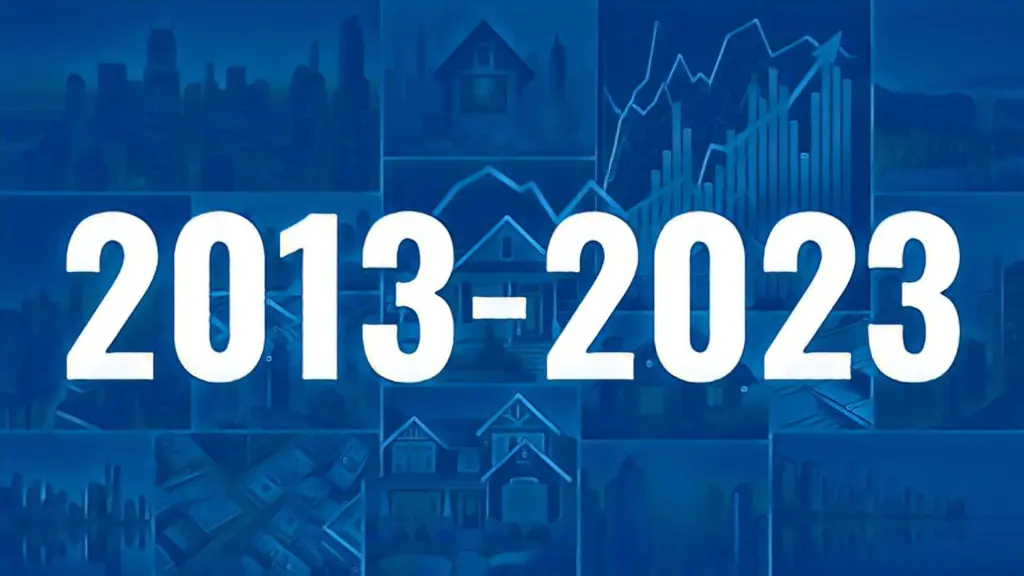Key Takeaways:
- The U.S. housing market has seen significant price and demand fluctuations from 2013 to 2023, impacting both buyers and sellers.
- Predictions for 2024 and beyond indicate continued evolution in both residential and commercial real estate markets.
- Real estate investors should consider market trends, mortgage rates, and economic forecasts to make informed decisions in 2023.

Introduction: 10-Year Real Estate Market Aerial View
The real estate market has always been a dynamic and vital part of the economy, shaping the lives and futures of millions.
From 2013 to 2023, we’ve witnessed remarkable shifts in home prices, market predictions, and overall trends that have redefined the landscape of buying and selling properties.
Exploring the 10-Year Trends in the US Housing Market
The real estate market, a cornerstone of the US economy, has undergone significant changes over the past decade, particularly between 2013 and 2023.
The shifts in home prices, market predictions, and overall trends have reshaped the landscape of property buying and selling.
As we examine these changes, it’s important to consider their implications: How have these market shifts influenced your view on real estate, and what might the future hold?

Evolution of the Housing Market (2013-2023)
The last decade in the real estate market has been a period of significant transformation.
From fluctuating mortgage rates to changes in housing demand, the market has experienced ups and downs that have impacted both buyers and sellers.
Understanding these shifts is key to grasping the market’s current state and its trajectory into 2024 and beyond.
Key Changes in the Housing Market Over the Last Decade
The last ten years in the real estate market have been marked by significant transformations.
The fluctuation of mortgage rates with the Fed at the wheel over the last ten years, (chairs of the Board of Governors of the Federal Reserve System: Ben S. Bernanke [2006–2014], Janet L. Yellen [2014–2018], and Jerome H. Powell [2018-present time of writing]) along with changes in housing demand, has led to varying market dynamics.
Understanding these shifts provides insight into the current market state and its potential direction in the coming years.
Mortgage Rates in 2013
- 2013 Overview: The year 2013 was characterized by relatively low mortgage rates, especially in the aftermath of the 2008 financial crisis. During this period, the U.S. economy was still in recovery mode, and the Federal Reserve maintained policies aimed at stimulating economic growth.
- Average Rates: In 2013, the average rate for a 30-year fixed mortgage hovered around 3.5% to 4.5%. These rates were influenced by the Federal Reserve’s quantitative easing program, which involved large-scale purchases of securities to keep interest rates low.
Mortgage Rates in 2023
- 2023 Overview: Fast forward to 2023, the scenario is quite different. The economic landscape has been impacted by various factors, including the COVID-19 pandemic, inflationary pressures, and the Federal Reserve’s responses to these challenges.
- Average Rates: As of early 2023, the average rate for a 30-year fixed mortgage was significantly higher, around 7.08% in March 2023, as noted in the housing market predictions. This increase is largely attributed to the Federal Reserve’s efforts to combat high inflation through rate hikes.
Trends and Fluctuations (2013-2023)
- Post-2013 Trends: After 2013, mortgage rates remained relatively low for several years, often fluctuating between 3% and 4.5%. This period was marked by a stable economic growth and continued accommodative monetary policy by the Federal Reserve.
- Pandemic Impact (2020-2021): During the COVID-19 pandemic, particularly in 2020 and 2021, mortgage rates reached historic lows. In 2020, rates frequently fell below 3%, driven by the Federal Reserve’s rate cuts to mitigate the economic impact of the pandemic.
- Rising Inflation and Fed Response (2021-2023): Starting in late 2021 and into 2023, the rates began to increase sharply. The Federal Reserve started raising rates to address rising inflation, which had been exacerbated by pandemic-related fiscal stimulus and supply chain disruptions.
- Volatility: The last decade, especially the period from 2020 to 2023, has been marked by significant volatility in mortgage rates, reflecting broader economic uncertainties and policy responses.
The mortgage rates in 2013 were significantly lower compared to those in 2023, with the intervening years characterized by historically low rates, especially during the pandemic, followed by a sharp increase in response to rising inflation and changes in monetary policy.
Analysis of Home Price Trends
One of the most notable aspects of the market over this period has been the trend in home prices.
The housing market has seen considerable ups and downs, influenced by various economic factors, including inflation and changes in mortgage rates.
The median home price in the US, for example, has seen significant fluctuations, reflecting the changing dynamics of the market.
Contrasting the median home prices in the United States between 2013 and 2023, along with the fluctuations over this decade, offers a perspective on the housing market trends and economic factors influencing them.
Median Home Prices in 2013
- 2013 Overview: In 2013, the U.S. housing market was in a recovery phase following the 2008 financial crisis. Prices were starting to rebound from their lows during the crisis.
- Median Prices: The median home price in 2013 was approximately $197,400. This represented a recovery from the lows of the crisis, but prices were still relatively moderate compared to pre-crisis peaks.
Median Home Prices in 2023
- 2023 Overview: The housing market in 2023 is influenced by post-pandemic dynamics, including supply chain disruptions, labor shortages, and increased demand.
- Median Prices: As of early 2023, the median home price had risen significantly. Although specific figures for 2023 may vary, it’s evident that prices have increased considerably from 2013 levels, influenced by factors like low mortgage rates (especially in the earlier part of the decade), supply shortages, and high demand.
Trends and Fluctuations (2013-2023)
- Recovery and Growth Post-2013: Following 2013, the U.S. housing market continued to recover, with steady increases in median home prices. This period was characterized by strengthening economic conditions and increasing demand.
- Pandemic Impact (2020-2021): The onset of the COVID-19 pandemic initially created uncertainty in the housing market. However, the market quickly rebounded and surged, driven by low mortgage rates, a desire for more living space, and limited housing supply.
- Continued Growth: Throughout 2021 and into 2022, median home prices continued to rise, reaching record levels in many areas. This was fueled by continued low mortgage rates, limited supply, and robust demand.
- Regional Variations: It’s important to note that the rate of price growth varied significantly across different regions and cities, with some areas experiencing more dramatic increases than others.
Median home prices in the U.S. have seen significant growth from 2013 to 2023, with the most notable increases occurring in the latter half of the decade, particularly during and after the COVID-19 pandemic.
This growth reflects a combination of economic factors, including low-interest rates, housing supply constraints, and changing consumer preferences.
Comparing inflation rates between 2013 and 2023 in the United States, and examining the fluctuations over the last decade, provides insight into the economic dynamics and policy responses during this period.
Inflation Rates in 2013
- 2013 Overview: The year 2013 was a period of moderate economic recovery following the 2008 financial crisis. Inflation rates were relatively subdued during this time.
- Average Rates: The average annual inflation rate in 2013 was about 1.5%. This rate was within the target range set by the Federal Reserve, reflecting a stable but slowly recovering economy.
Inflation Rates in 2023
- 2023 Overview: The economic context in 2023 is quite different, marked by the aftermath of the COVID-19 pandemic, supply chain disruptions, and various global factors.
- Average Rates: In late 2022, the inflation rate was running at more than 7%. This elevated level was due to a combination of factors, including pandemic-related fiscal stimulus, supply chain issues, and rebounding consumer demand.
Trends and Fluctuations (2013-2023)
- Post-2013 Stability: Following 2013, inflation rates in the U.S. remained relatively stable and within the Federal Reserve’s target of around 2%. This period saw consistent but modest economic growth.
- Pandemic Impact (2020-2021): The onset of the COVID-19 pandemic in early 2020 led to an initial dip in inflation due to decreased demand. However, subsequent fiscal stimulus measures and economic recovery efforts, combined with supply chain bottlenecks, began to drive inflation rates higher.
- Surge in 2021-2023: Inflation rates surged in late 2021 and throughout 2022, reaching levels not seen in several decades. This was a result of a complex mix of factors, including continued pandemic-related disruptions, supply chain challenges, and significant consumer demand as economies reopened.
- Federal Reserve’s Response: In response to rising inflation, the Federal Reserve shifted its policy stance, moving from low-interest rates and quantitative easing to a series of interest rate hikes aimed at cooling the economy and bringing inflation down.
Overall, the contrast between 2013 and 2023 in terms of inflation is stark, with the latter period experiencing significantly higher rates.
The decade between these years saw relatively stable inflation, followed by a dramatic increase in response to unique economic challenges posed by the pandemic and global supply chain issues.
Impact of economic factors on the real estate market
Economic factors have played a critical role in shaping the housing market.
Factors like inflation, federal policies, and mortgage rates have directly influenced home prices and the overall market conditions.
The actions of the Federal Reserve, especially in response to inflation, have had a substantial impact on mortgage rates, which in turn affect home affordability and buyer behavior.

Mortgage Market Insights: Understanding Rates and Forecasts
Mortgage rates are a key driver of the real estate market.
Understanding their current trends and future forecasts is essential for anyone looking to buy a home or invest in real estate.
This section touches on the impact of these rates and what they mean for the market as we head into 2024 and beyond.
Impact of Mortgage Rates On the Housing Market
Mortgage rates have a significant impact on the housing market.
The fluctuations in rates, particularly the increase in 2023 and the expected decrease in 2024 influence buyer affordability and market activity.
Understanding these trends is crucial for potential buyers and real estate investors.
Forecasting mortgage market trends in 2023 and beyond
The forecast for the mortgage market in 2024 suggests a slight decrease in rates, which could lead to an increase in buyer activity.
However, the rates are still expected to remain relatively high, influencing buyer decisions and the overall market dynamics.
30-year mortgage rate trends and predictions
The trend in 30-year mortgage rates provides insights into the long-term market outlook.
While current rates are significantly higher than their all-time low in 2021, they are still close to the historic average.
This trend suggests a potential stabilization of the market, albeit at a higher cost level than in recent years.

Housing Inventory and Market Dynamics
The balance between housing inventory and market demand significantly influences real estate dynamics.
This section will explore the current state of housing supply, the role of commercial real estate, and how these factors affect both buyers and sellers in today’s market.
Current State of Housing Inventory
Housing inventory, a critical factor in market dynamics, has been on a downward trajectory.
The number of existing homes for sale has dwindled, impacting buyer choices and market behavior.
This trend is expected to continue in 2024, with limited housing supply influencing market dynamics.
Analysis of buyers and sellers in the market
The interaction between buyers and sellers is central to understanding market dynamics.
The housing market in 2024 is expected to see a continuation of high costs, which will influence the decisions of existing homeowners and potential buyers.
Moves of necessity, such as job changes or family situation changes, are likely to drive home sales.
Generational trends affecting the real estate landscape
Generational trends, including the behaviors of Millennials and Gen Z, are shaping the housing market.
These groups face unique challenges in the current market, such as the need for larger down payments and the high cost of homeownership.
These trends are likely to continue to influence the market in the coming years.

Housing Market Predictions: Forecast for 2024 and Beyond
As we look towards the future, making accurate housing market predictions becomes increasingly important.
The next five years are poised to be pivotal, with forecasts indicating changes in home prices and market dynamics.
Analyzing these trends is crucial for anyone involved in the real estate market, from first-time homebuyers to seasoned investors.
Market Predictions for the Next 5 Years
Looking ahead, the housing market predictions for the next five years suggest a mix of continuity and change.
The market in 2024 is expected to see a slight adjustment in home prices, with existing home median price appreciation projected at -1.7%.
The forecast also indicates a stabilization in home sales, with existing home sales expected to marginally increase by 0.1% year over year.
The United States real estate market is expected to undergo various changes in the coming years, influenced by factors such as economic conditions, housing supply, and consumer behavior.
Here’s a summary of key predictions for the next five years:
- Economic and Inflation Trends: The U.S. economy in 2023 is expected to show mixed performance with a slowdown in momentum due to restrictive fiscal policy and high inflation. Inflation is anticipated to remain a significant factor but is showing signs of peaking, with a gradual improvement expected in supply chain disruptions.
- Federal Reserve’s Policy: The Federal Reserve’s aggressive tightening policy, initiated to control inflation, will likely continue into the first half of 2023. The Fed Funds rate is expected to peak around 5% before any rate cuts are considered, which might not occur until late 2023 or 2024.
- Housing Market Dynamics: The housing market is expected to normalize, with home price growth slowing down. For instance, home prices are predicted to increase by 3.1% from January 2023 to January 2024, a slower pace compared to previous years. Rent growth might outpace home price appreciation, and the number of renters is expected to rise due to the high cost of homeownership.
- Mortgage Rates and Home Sales: Mortgage rates will likely remain volatile throughout 2023. As rates increase, home sales are expected to decline, with a potential 15-20% drop from current levels. The rise in mortgage rates has significantly impacted affordability, pushing more people towards renting.
- First-Time Homebuyers: The proportion of first-time homebuyers in the market has been decreasing, partly due to rising rents and ongoing inflation affecting savings. However, they are expected to regain their pre-pandemic market share by 2024 and 2025.
- Housing Inventory Shortages: Shortages in housing inventory might persist until 2024, affected by factors like labor shortages, restrictive zoning, and low builder confidence. This shortage is particularly evident in the single-family home segment.
- Remote Work Impact: Young buyers, encouraged by remote work opportunities, are likely to continue moving to affordable markets in the Midwest, South, and Sunbelt regions.
- Joint Real Estate Purchases: There’s an expected rise in joint real estate purchases, driven by the high cost of homeownership and the challenges in qualifying for mortgages on single incomes.
- Employment and Consumer Spending: While employment growth has been strong, a potential slowdown in demand for workers might occur later in 2023 and into 2024. However, strong labor income growth has helped maintain relatively high household incomes and consumption levels.
- Real Estate Sectors: High-quality commercial spaces are likely to outperform, with low vacancy rates and high rents. Retail sectors have shown resilience, with increased consumer spending in physical locations. The rental sector, benefiting from housing shortages, might see normalization in 2023 due to economic uncertainties.
- Capital Market Activity: The risk premium has been high due to uncertainties around the Fed’s interest rate increases and the overall economy’s growth. A reduction in these uncertainties is expected to boost capital market activities.
- Office Sector Distress: Some distress is anticipated in the non-institutional office assets sector, with challenges in valuations, demand, and debt availability leading to higher levels of forced sales and distress.
The U.S. real estate market is facing a period of transition with slower growth, changing dynamics in both the residential and commercial sectors, and a potential shift in buyer behavior influenced by economic conditions and policy decisions.
Below is a data table summarizing the key predictions for the United States real estate market over the next five years.
| Category | Details |
|---|---|
| Economic Trends | – Mixed performance in 2023 with a slowdown in growth. High inflation but showing signs of peaking. Restrictive fiscal policy impacts. |
| Federal Reserve Policy | – Aggressive rate hikes in 2022, expected to continue into 2023. Fed Funds rate to peak around 5%. Potential rate cuts not expected until late 2023 or 2024. |
| Housing Market Normalization | – Slower home price growth; 3.1% increase predicted from Jan 2023 to Jan 2024. Rent growth might surpass home price appreciation. Increase in renters due to high homeownership costs. |
| Mortgage Rates and Home Sales | – Volatile mortgage rates in 2023. Potential 15-20% decline in home sales. High rates impacting affordability and market accessibility. |
| First-Time Homebuyers | – Decreasing proportion in recent years, but expected to regain pre-pandemic market share by 2024-2025. |
| Housing Inventory Shortages | – Likely to persist until 2024 due to labor shortages, zoning, and low builder confidence. Shortage more pronounced in single-family homes. |
| Impact of Remote Work | – Movement of young buyers to affordable markets in the Midwest, South, and Sunbelt. |
| Joint Real Estate Purchases | – Increase in joint purchases due to high homeownership costs and mortgage qualifying challenges. |
| Employment and Spending | – Strong labor income growth maintains high household incomes and consumption. Potential slowdown in worker demand in late 2023 and 2024. |
| Sectoral Performance | – High-quality commercial spaces outperforming. Resilient retail sector with increasing physical location spending. Rental sector normalization expected in 2023. |
| Capital Market Activity | – High risk premium due to interest rate and economic uncertainties. Expected increase in activity as uncertainties reduce. |
| Office Sector | – Distress expected in non-institutional office assets due to valuation and demand challenges. |
Forecasting the Housing Market in 2024
The forecast for 2024 suggests a complex picture.
While mortgage rates are expected to begin a slow retreat, improving housing affordability, they are projected to average 6.8% for the year.
This shift from climbing to falling mortgage rates is anticipated to impact housing demand and sales, leading to a relatively stable market with lower levels of home sales.
Factors Influencing Future Market Trends
Several factors are likely to influence future market trends.
These include economic growth, unemployment rates, and interest rates.
The interaction of these factors will shape the market dynamics in 2024 and beyond.
For instance, the anticipated easing of inflation is expected to influence mortgage rates, thereby affecting buyer demand and home affordability.

Analyzing the Risks: Will There Be a Housing Market Crash in 2024?
The possibility of a housing market crash in 2024 is a topic of concern for many.
Evaluating this risk involves looking at current market conditions, including rising home prices and mortgage rates.
When you understand these factors, you can better predict the likelihood of a market downturn and its potential impact.
Evaluating the likelihood of a housing market crash
The potential for a housing market crash in 2024 has been a subject of much speculation.
Historical data and economic indicators suggest that while there might be a market adjustment, a crash akin to the 2008 crisis is less likely.
Factors such as a slow retreat in mortgage rates and stabilizing home sales contribute to this outlook.
Historical comparisons and economic indicators
Economic indicators, including employment rates, inflation, and mortgage rates, play a significant role in assessing the likelihood of a market crash.
The gradual decrease in mortgage rates and the modest economic growth projected for 2024 suggest a stabilizing market rather than a drastic downturn.
Comparing employment rates and the prevalence of remote work between 2013 and 2023 in the United States provides insights into labor market trends and their implications for the commercial real estate sector.
Employment Rates in 2013
- 2013 Overview: In 2013, the U.S. was recovering from the Great Recession. Employment rates were gradually improving, but the job market was still regaining strength.
- Employment Rates: The unemployment rate in 2013 averaged around 7.4%. This was a noticeable improvement from the peak rates during the recession but still higher than pre-recession levels.
Employment Rates in 2023
- 2023 Overview: The labor market in 2023 is shaped by the aftermath of the COVID-19 pandemic, with various industries experiencing different recovery rates.
- Employment Rates: In early 2023, the unemployment rate was significantly lower, around 3.6% to 4.3%. This reflects a tight labor market with strong demand for workers, although some sectors were still recovering from pandemic impacts.
Trends and Fluctuations (2013-2023)
- Gradual Improvement (2013-2019): From 2013 to 2019, the U.S. saw steady employment growth. The unemployment rate consistently decreased, reaching as low as around 3.5% by the end of 2019.
- Pandemic Impact (2020-2021): The onset of the pandemic caused a sharp increase in unemployment, with rates soaring to around 14.8% in April 2020. However, a significant recovery followed, albeit with variations across industries.
- Post-Pandemic Recovery (2021-2023): By 2021 and into 2023, the unemployment rate had substantially decreased, indicating a strong rebound in many sectors, although issues like labor shortages and changing work patterns remained.
Remote Work and Commercial Real Estate (2013-2023)
- 2013 Scenario: In 2013, remote work was relatively less common, mostly limited to specific sectors or roles. The commercial real estate market was largely driven by traditional office space requirements.
- 2023 Scenario: By 2023, the prevalence of remote work had increased dramatically, largely due to the pandemic. Many companies adopted flexible or fully remote work policies.
- Impact on Commercial Real Estate: This shift impacted the commercial real estate market significantly. Demand for traditional office spaces decreased, while interest in flexible workspaces or co-working spaces increased. There was a notable shift in the design and utilization of office spaces to accommodate hybrid work models.
- Percentage Fluctuations: Quantifying the exact percentage fluctuation in remote work and its direct impact on commercial real estate is complex due to varying policies across companies and the evolving nature of work models. However, it’s clear that the increase in remote work post-2020 has led to a reevaluation of commercial real estate needs, with a trend towards more versatile and hybrid-friendly spaces.
In summary, from 2013 to 2023, the U.S. experienced significant fluctuations in employment rates, with a marked improvement over the decade.
The rise of remote work, especially post-2020, has had a profound impact on the commercial real estate market, influencing demand, design, and utilization of office spaces.
Impact of mortgage rates on market stability
Mortgage rates are a critical factor in determining market stability.
The forecast for 2024 indicates a decline in mortgage rates, which is expected to improve housing affordability and stabilize the market.
This trend reduces the likelihood of a market crash but suggests a need for vigilance against potential economic shifts.

Commercial Real Estate Shift: Trends and Predictions
While much of the focus in real estate discussions centers on residential properties, the commercial real estate market has also undergone significant transformations from 2013 to 2023.
This sector, encompassing office spaces, retail locations, and industrial properties, reacts differently to economic changes than the housing market.
Understanding these dynamics is crucial for investors and businesses alike.
CRE Evolution Since 2013
Since 2013, the commercial real estate market has seen its own set of challenges and growth opportunities.
The rise of e-commerce and remote work, especially accelerated by the pandemic in 2020 and 2021, has reshaped demand for retail and office spaces.
Meanwhile, industrial real estate, particularly warehousing and logistics centers, has experienced a boom due to increased online shopping.
Key Data Points
- Shift in Office Space Demand: Reports from commercial real estate agencies highlight the decline in traditional office space demand, contrasted with a rise in flexible workspaces.
- Retail Space Transformation: Data from the National Association of Realtors® shows the evolving landscape of retail spaces, with a trend towards experiential retail.
- Industrial Real Estate Growth: Statistics from the U.S. Department of Commerce reflect the growth in demand for industrial properties, driven by e-commerce.
Exploring commercial real estate occupancy rates between 2013 and 2023, along with fluctuations over the last decade, provides an understanding of how market dynamics have shifted, particularly in light of economic and societal changes.
Commercial Real Estate Occupancy Rates in 2013
- 2013 Overview: In 2013, the U.S. commercial real estate market was in a recovery phase following the 2008 financial crisis. The market was gradually stabilizing and starting to see growth in demand.
- Occupancy Rates: While specific nationwide occupancy rates for 2013 vary by sector (office, retail, industrial), they were generally improving. For office spaces, occupancy rates were recovering, but still below pre-crisis levels. Retail and industrial sectors were similarly experiencing gradual improvements.
Commercial Real Estate Occupancy Rates in 2023
- 2023 Overview: By 2023, the commercial real estate market had been significantly affected by the COVID-19 pandemic, leading to shifts in how spaces are used, particularly in office and retail sectors.
- Occupancy Rates: The occupancy rates in 2023 reflect these changes. Office spaces, in particular, have seen fluctuations due to the rise of remote work and hybrid work models. Retail spaces have been influenced by the growth of e-commerce, while industrial and warehouse spaces have generally seen increased demand due to online shopping trends.
Trends and Fluctuations (2013-2023)
- Post-2013 Recovery: Between 2013 and 2019, commercial real estate sectors generally saw a steady increase in occupancy rates, with growing economic confidence and business expansions.
- Pandemic Impact (2020-2021): The onset of the pandemic in 2020 led to a significant disruption in commercial real estate. Office spaces saw a decline in occupancy due to remote work policies. Retail spaces were also affected as consumer behavior shifted rapidly towards online shopping.
- Adjustments and Resilience (2021-2023): In the subsequent years, the market began adjusting to new realities. While office spaces struggled with lower occupancy rates, industrial and logistics real estate benefited from the e-commerce boom. Retail spaces started adapting to new consumer habits, impacting their occupancy rates.
- Percentage Fluctuations: Quantifying the exact percentage fluctuations in occupancy rates across all commercial sectors is complex due to regional variations and differing impacts on each sector. However, the general trend indicates a decrease in occupancy rates for office and certain retail spaces, while industrial and logistics sectors experienced growth in demand and occupancy.
The commercial real estate occupancy rates from 2013 to 2023 show a market that has undergone significant transformations.
The pandemic has been a major catalyst for change, particularly affecting office and retail spaces, while boosting demand for industrial and warehouse properties.
The percentages of fluctuations in occupancy rates vary across sectors, reflecting these broader economic and social shifts.
Future Predictions for Commercial Real Estate
Looking ahead, the commercial real estate market is poised for further evolution.
The continued growth in e-commerce is expected to sustain the demand for industrial spaces, while office and retail sectors may see a shift towards more adaptive and multi-use designs.
This evolution presents both challenges and opportunities for real estate investors and businesses planning for the next five years.

Home Buyer’s Guide: Is Now the Right Time to Buy a House?
For prospective homebuyers, timing is everything.
The current state of the housing market, influenced by factors such as housing affordability and mortgage rates, plays a critical role in deciding when to enter the market.
This section will provide insights and tips for those looking to make a home purchase in 2023.
Assessing current home prices and values
For potential homebuyers, understanding the current market conditions is crucial.
The forecast for 2024 shows a market that is adjusting, with slight dips in home prices and a gradual decrease in mortgage rates.
This suggests that while the market may be more favorable than in recent years, buyers should still exercise caution and evaluate their financial readiness.
Mortgage rate trends and their impact on buyers
Mortgage rates have been a key factor influencing buyer decisions.
In 2023, the average 30-year fixed mortgage rate fluctuated between 6% and 7%, impacting affordability and buyer behavior.
With rates expected to ease in 2024, buyers might find more favorable conditions for purchasing a home.
Tips for buyers in the 2023 housing market
For those considering entering the market in 2023, it’s important to stay informed about market trends and forecasts.
Factors such as housing affordability, mortgage rates, and personal financial readiness should guide the decision-making process.
Using tools like mortgage calculators and seeking advice from real estate professionals can aid in making informed decisions.

Real Estate Investor’s Guide: Is This the Right Time to Invest?
For real estate investors, timing the market is a critical factor in maximizing returns and minimizing risks.
With the fluctuations in the housing and commercial real estate markets from 2013 to 2023, understanding the current landscape is key to making informed investment decisions.
All things relative to your personal risk tolerance and investing strategy, of course, this section will explore whether now is an opportune moment for real estate investment.
Assessing the Current Investment Climate
The past decade has seen varying market conditions, from the rapid growth in home prices to the evolving dynamics of commercial real estate.
Factors such as interest rates, housing market trends, and economic forecasts play a significant role in determining the attractiveness of real estate investments.
Currently, with the housing market experiencing relative stabilization and the commercial sector undergoing transformation, investors are faced with a complex but potentially rewarding market.
Key Considerations for Investors
- Market Predictions for the Next Five Years: Trends reports and forecasts from chief economists provide insights into where the real estate market is headed, aiding in long-term investment planning.
- Impact of Mortgage Rates and Inflation: Understanding how current mortgage rates and inflation rates impact investment returns is crucial.
- Diversification Across Property Types: With shifts in demand for different types of properties, diversifying investments across residential and commercial real estate could mitigate risks.
Real Estate Investment Opportunities in 2023
The real estate market in 2023 presents unique opportunities for investors.
With a balanced approach, considering both the residential and commercial sectors, and staying informed about the latest market conditions, investors can navigate the current landscape effectively.
The key is to take your time to understand local market trends, anticipate future changes, and adapt your strategies accordingly.

Assessment
Reflecting on the past decade and looking ahead, this analysis offers a comprehensive view of the real estate market’s evolution.
From market predictions to housing inventory, understanding these trends is vital for navigating the market.
As we conclude, consider how these insights can inform your decisions in the ever-evolving world of real estate.
Final Thoughts
As we move into the next phase of the housing market, staying informed about these trends and developments is crucial.
Whether you’re a potential homebuyer, seller, or investor, understanding the dynamics of the market is key to making informed decisions.
The years ahead promise both challenges and opportunities in the real estate landscape.
For those looking to enter the housing market, either as buyers or sellers, staying informed about the latest trends and forecasts is essential.
Using tools and resources available, such as affordability calculators and market reports, can help navigate the complexities of the market.
Being prepared and informed is key to making the most of the opportunities the real estate market offers.
References
- Bay Area Market Reports [1]
- Berkadia [1]
- Bigger Pockets [1] [2]
- CBRE [1]
- CNBC [1]
- College Township [1]
- Congressional Budget Office [1]
- CoreLogic [1]
- DQYDJ [1]
- Federal Reserve [1]
- Forbes [1]
- Fortune [1]
- FRBSF [1]
- Garrett’s Realty [1]
- Go Banking Rates [1]
- Grandview Research [1]
- Green Street [1]
- Harvard JCHS [1]
- HUD User [1]
- Jackson Hole Real Estate Report [1]
- JLL [1] [2]
- JP Morgan Chase [1]
- Miller Samuel [1]
- NAR Realtor [1] [2]
- Norada Real Estate [1]
- PwC [1]
- Ramsey Solutions [1] [2]
- Rate.com [1]
- Real Estate Magazine Canada [1]
- Realtor.com [1]
- Redfin [1] [2]
- REIT [1]
- Rocket Mortgage [1]
- Statista [1] [2] [3]
- The Local Reporter [1]
- The Mortgage Reports [1]
- US Department of Commerce [1]
- US News Real Estate [1]
- Visual Capitalist [1]
- Washington State Office of Financial Management [1]
- White House [1]
- Windermere Real Estate [1]
No related posts.



























